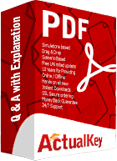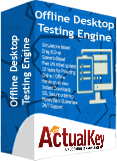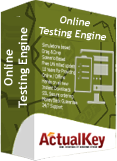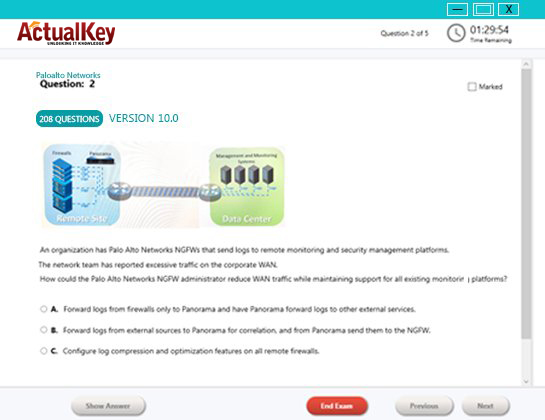Limited Time 30% Discount Offer Use Code - off30
Actualkey Prepration Latest 1Z0-1093-25 : Oracle Cloud Database Services 2025 Professional Exam Questions and Answers PDF's, Verified Answers via Experts - Pass Your Exam For Sure and instant Downloads - "Money Back Guarantee".
| Vendor | Oracle |
| Certification | Oracle Cloud Solutions |
| Exam Code | 1Z0-1093-25 |
| Title | Oracle Cloud Database Services 2025 Professional Exam |
| No Of Questions | 99 |
| Last Updated | April 9,2025 |
| Product Type | Q & A with Explanation |
| Bundel Pack Included | PDF + Offline / Andriod Testing Engine and Simulator |
Format: Multiple Choice
Duration: 90 Minutes
Number of Questions: 50
Passing Score: 68%
Validation: This exam has been validated against Oracle Cloud Infrastructure 2025
Policy: Cloud Recertification
Earn associated certifications
Passing this exam is required to earn these certifications. Select each certification title below to view full requirements.
Oracle Cloud Database Services 2025 Certified Professional
Prepare to pass exam: 1Z0-1093-25
An Oracle Cloud Database Services 2025 Certified Professional has demonstrated the knowledge and skills required to implement Oracle Database Cloud Service on the Oracle Cloud Infrastructure (OCI) platform.
They can configure and monitor Oracle Base Database services, deploy Exadata DBs, manage MySQL Database and HeatWave, understand the NoSQL Database Cloud Service requirements and describe the Oracle Cloud Infrastructure Database Management service.
Take recommended training
Complete one of the courses below to prepare for your exam (optional):
Become an Oracle Cloud Database Service Professional - 2025
Additional Preparation and Information
A combination of Oracle training and hands-on experience (attained via labs and/or field experience), in the learning subscription, provides the best preparation for passing the exam.
Review exam topics
The following table lists the exam objectives and their weightings.
Base Database Service - VM (BaseDB) 20%
Exadata Database Service (ExaDB) 20%
MySQL HeatWave Technical Overview 20%
NoSQL Database Service Technical Overview 20%
Oracle Cloud Infrastructure Database Management Service 20%
Base Database Service - VM (BaseDB)
Describe Base Database Service
Provisioning Base Database Service
Explain BaseDB - Database Lifecycle Management
Explain BaseDB - Backup and Recovery
Patch and Upgrade BaseDB User Managed Components
Describe Base Database Service Monitoring & Management Interfaces
Exadata Database Service (ExaDB)
Explain the Exadata Database Service
Provision Exadata Database Service
Explain Exadata Cloud Infrastructure and VM Cluster Management
Explain Exadata Database Lifecycle Management
Explain Exadata Database Service Management Interfaces & Utilities
MySQL HeatWave Technical Overview
Describe the MySQL HeatWave
Provision MySQL HeatWave
Migrate a MySQL Instance To MySQL HeatWave
Explain MySQL HeatWave OLAP AutoML Lakehouse
Operate MySQL HeatWave
NoSQL Database Service Technical Overview
Describe NoSQL
Explain Table Security Management
Explain Table Rate Limiting
Describe NoSQL data models
Explain provisioned throughput for NoSQL Database Cloud Service
Describe NoSQL language SDKs
Oracle Cloud Infrastructure Database Management Service
Describe the Oracle Cloud Infrastructure Database Management Service
Enable database management service for cloud databases
Monitor cloud databases
Perform diagnostics and tuning for cloud databases
Administer cloud databases
Sample Question and Answers
QUESTION 1
Which technology within the Exadata Database Service provides intelligent data offloading and processing capabilities directly within the storage tier?
A. Oracle Data Guard
B. Exadata Smart Scan
C. Oracle Active Data Guard
D. Exadata Smart Flash Cache
Answer: B
Explanation:
Exadata Smart Scan:
This technology is a core feature of Exadata storage servers. It allows the storage servers to perform
data filtering, projection, and other processing tasks directly within the storage tier before sending
the results to the database compute nodes. This significantly reduces the amount of data transferred
over the network, leading to improved query performance.
Why the other options are incorrect:
A . Oracle Data Guard: Used for disaster recovery and high availability, not for in-storage processing.
C . Oracle Active Data Guard: Allows read-only access to a standby database, but doesnt provide instorage processing.
D . Exadata Smart Flash Cache: Used for caching frequently accessed data in flash memory to
improve I/O performance. While it enhances performance, it does not provide intelligent data offloading and processing within the storage tier. Reference:
Oracle Exadata Database Service Documentation
QUESTION 2
Which two requirements must be met before you can create an Exadata Database Service VM Cluster?
A. A configured Oracle Cloud Infrastructure (OCI) Vault and Key.
B. A Virtual Cloud Network (VCN) with necessary subnets for client access and backups.
C. A valid support identifier (SI) associated with the OCI account.
D. A configured Exadata Cloud@Customer infrastructure.
E. An Exadata Infrastructure resource must be created first.
Answer: B, E
Explanation:
B . VCN and Subnets:
Exadata Database Service VM Clusters require a VCN to provide network connectivity for database
instances, client access, and backups. Proper subnets are essential for this network setup.
E . Exadata Infrastructure Resource:
Before creating a VM Cluster, an Exadata Infrastructure resource must be provisioned. The VM Cluster resides within this infrastructure.
Why the other options are incorrect:
A: OCI Vault and Key are used for encryption but not mandatory for VM Cluster creation.
C: A valid SI is needed for support but not a technical requirement for VM cluster creation.
D: Exadata Cloud@Customer is a separate service from Exadata Database Service.
Reference:
Oracle Exadata VM Cluster Documentation
QUESTION 3
Which statement accurately describes the primary function of a NoSQL Database Cloud Service SDK?
A. To define the physical storage layout of the database.
B. To provide a programming interface for interacting with the database, abstracting away low-level API details.
C. To manage the underlying infrastructure hosting the NoSQL database.
D. To configure network security policies for accessing the database.
Answer: B
Explanation:
SDK Function:
An SDK simplifies database interaction by providing libraries and tools that abstract away the
complexities of the underlying API. This allows developers to use familiar programming languages
and constructs to interact with the database.
Why the other options are incorrect:
A: Physical storage layout is managed by the database service, not the SDK.
C: Infrastructure management is handled by cloud providers, not the SDK.
D: Network security policies are managed via OCI console or infrastructure tools, not the SDK.
Reference:
Oracle NoSQL Database Service Documentation
QUESTION 4
Which two statements accurately describe the relationship between Database Management andmetrics collected in OCI Monitoring service?
A. Database Management retrieves performance data exclusively from the OCI Monitoring service and does not directly query the database.
B. Database Management directly queries the database for detailed performance data and supplements it with metrics from the OCI Monitoring service.
C. Database Management's data collection is completely independent of the OCI Monitoring service.
D. Database Management relies on custom metrics uploaded to OCI Monitoring by the user in order to provide its monitoring features.
Answer: B, C
Explanation:
B: Database Management directly queries the database to gather performance data, such as SQL
performance and active session history. It also integrates with OCI Monitoring for infrastructure-level metrics like CPU, memory, and storage utilization.
C: Database Management can function independently of OCI Monitoring since it has its own data collection mechanisms.
Why the other options are incorrect:
A: Database Management does not rely solely on OCI Monitoring.
D: It does not require custom metrics from the user.
Reference:
Oracle Database Management Service Documentation
QUESTION 5
The concept of 'schema-less' in the context of NoSQL databases primarily refers to what?
A. The database automatically infers the schema from the data being inserted, without requiring any explicit schema definition beforehand.
B. All data stored within the database must conform to a single, universally defined schema for consistency.
C. Data is stored in a highly structured format, mirroring the tabular structure of relational databases with predefined columns and data types.
D. Data is stored in a binary format, eliminating the need for any schema or data interpretation.
Answer: A
Explanation:
Schema-less in NoSQL:
This means you don't need to define a rigid, fixed structure before data insertion. Each record can
have its own structure, allowing flexibility for evolving data models. This is useful for unstructured or
I Got My Success Due To Actualkey 1Z0-1093-25 Bundle Pack Actualkey experts I got passed in the 1Z0-1093-25 exam without any worries at all, these exam material products gave me the reason to relax.
Budi Saptarmat
Yahoo! Got Successfully Through The 1Z0-1093-25 Exam Passing Exam is not a easy thanks to Acutalkey.com for providing me actual 1Z0-1093-25 Oracle Cloud Database Services 2025 Professional Exam training with there included the Offline and Android simulators helps me success
Melinda
1Z0-1093-25 Exam Best Preparation I have been preparing for 1Z0-1093-25 Oracle Cloud Database Services 2025 Professional Exam, I was not sure that I'll be able to pass because of the fact that I am not a good student however;Actualkey.com provided me best and simple exam training pdf's and I passed. I now recommend everyone
Antonio Moreno
Actualkey.com 1Z0-1093-25 Offline Simulator is Best My choice to select Actualkey.com and go for the preparation 1Z0-1093-25 Oracle Cloud Database Services 2025 Professional Exam, because I got the short way with the easy way
Liliane Meichner
Actualkey.com 1Z0-1093-25 Exam PDF"s passed with in a week 1Z0-1093-25 exam pdf's that's amazing
James Wilson
Oracle - RELATED EXAMS
Oracle Comm. Billing & Revenue Management: Server Administrator
Questions: 310 | May 8, 2024
Oracle E-Business Suite R12: General Ledger and Receivables Fundamentals
Questions: 330 | May 8, 2024
Oracle E-Business Suite R12: General Ledger and Payables Fundamentals
Questions: 330 | January 5, 2024
Oracle EBS R12: Inventory and Order Management Fundamentals
Questions: 302 | January 5, 2024
Oracle Database 11g: New Features for 9i OCPs Practice Test
Questions: 297 | January 5, 2024
PeopleSoft Application Developer I: People Tools & PeopleCode Practice Test
Questions: 191 | January 5, 2024
Siebel 7.7 Analytics App. Developer Professional Core Exam Practice Test
Questions: 78 | January 5, 2024
PeopleSoft Application Developer II:App Engine & Integration
Questions: 102 | January 5, 2024
Oracle Application Express 3.2: Developing Web Applications
Questions: 52 | January 11, 2024
JD Edwards EnterpriseOne Financial Management 9.0 Essentials
Questions: 72 | January 11, 2024
JD Edwards EnterpriseOne 9 Configurable Network Computing Essentials
Questions: 77 | January 11, 2024
Java Standard Edition 6 Programmer Certified Professional Upgrade Exam
Questions: 96 | August 1, 2024
Java Standard Edition 6 Programmer Certified Professional Exam
Questions: 290 | August 1, 2024
Java Enterprise Edition 5 Web Component Developer Certified Professional Exam
Questions: 276 | August 1, 2024
Java Standard Edition 5 Programmer Certified Professional Exam
Questions: 362 | August 1, 2024
Java Enterprise Edition 5 Web Component Developer Certified Professional Upgrade Exam
Questions: 119 | August 1, 2024
Java Standard Edition 5 Programmer Certified Professional Upgrade Exam
Questions: 138 | August 1, 2024
Oracle Business Intelligence Applications 7.9.6 for ERP Essentials
Questions: 71 | January 11, 2024
MySQL 5 Database Administrator Certified Professional Exam, Part I
Questions: 139 | January 11, 2024
MySQL 5 Database Administrator Certified Professional Exam, Part II
Questions: 138 | January 11, 2024
Java Platform, Enterprise Edition 6 Web Services Developer Certified Expert Exam
Questions: 120 | January 11, 2024
Java Enterprise Edition 5 Business Component Developer Certified Professional Exam
Questions: 305 | January 11, 2024
Java Mobile Edition 1 Mobile Application Developer Certified Professional Exam
Questions: 340 | January 11, 2024
Java Enterprise Edition 5 Business Component Developer Certified Professional Upgrade Exam
Questions: 150 | August 1, 2024
Java Enterprise Edition 5 Web Services Developer Certified Professional Exam
Questions: 183 | August 1, 2024
Java Enterprise Edition 5 Web Services Developer Certified Professional Upgrade Exam
Questions: 96 | August 1, 2024
Oracle Solaris Cluster 3.2 System Administrator Certified Professional Exam
Questions: 243 | August 1, 2024
Java Enterprise Edition 5 Enterprise Architect Certified Master Upgrade Exam
Questions: 144 | August 1, 2024
Oracle Solaris 10 System Administrator Certified Professional Exam, Part I
Questions: 301 | August 1, 2024
Oracle Solaris 10 System Administrator Certified Professional Upgrade Exam
Questions: 612 | August 1, 2024
Oracle Solaris 10 Network Administrator Certified Expert Exam
Questions: 317 | August 1, 2024
Java Enterprise Edition 5 Enterprise Architect Certified Master Exam (Step 1 of 3)
Questions: 238 | August 1, 2024
Oracle Solaris 10 Security Administrator Certified Expert Exam
Questions: 293 | August 1, 2024
Oracle Solaris 10 System Administrator Certified Professional Exam
Questions: 356 | January 11, 2024
Primavera P6 Enterprise Project Portfolio Management Essentials
Questions: 70 | August 1, 2024
Oracle RAC 11g Release 2 and Grid Infrastructure Administration
Questions: 139 | January 11, 2024
Siebel Customer Relationship Management (CRM) 8 Business Analyst
Questions: 74 | January 11, 2024
Java Platform, Enterprise Edition 6 Java Persistence API Developer Certified Expert Exam
Questions: 63 | January 11, 2024
Oracle Unified Business Process Management Suite 11g Essentials
Questions: 77 | January 11, 2024
Oracle E-Business Suite R12.1 Human Capital Management Essentials Exam
Questions: 80 | May 1, 2024
Java Platform, Enterprise Edition 6 Enterprise JavaBeans Developer Certified Expert Exam
Questions: 90 | January 11, 2024
Oracle FLEXCUBE UBS 11 Basic Implementation Essentials Exam
Questions: 76 | January 11, 2024
Oracle User Productivity Kit 11 Technical Consultant Essentials Exam
Questions: 115 | January 11, 2024
Oracle ATG Web Commerce 10 Implementation Developer Essentials
Questions: 86 | January 11, 2024
Primavera P6 Enterprise Project Portfolio Management 8 Essentials Exam
Questions: 84 | January 11, 2024
Oracle Fusion Human Capital Management 11g Human Resources Essentials
Questions: 129 | January 11, 2024
Oracle Business Intelligence Foundation Suite 11g Essentials
Questions: 120 | January 11, 2024
Oracle Fusion Customer Relationship Management 11g Sales Essentials
Questions: 133 | January 11, 2024
Oracle Fusion Middleware 11g: Build Applications with Oracle Forms Exam
Questions: 90 | January 11, 2024
Oracle Fusion Financials 11g Accounts Receivable Essentials
Questions: 123 | January 11, 2024
Java Enterprise Edition 6 Enterprise Architect Certified Master Exam (Step 1 of 3)
Questions: 90 | July 1, 2024
Oracle Exadata Database Machine Administration, Software Release 11.x
Questions: 72 | July 1, 2024
Oracle GoldenGate 11g Certified Implementation Exam Essentials
Questions: 79 | January 15, 2024
Exadata Database Machine Models X3-2 and X3-8 Implementation Essentials
Questions: 71 | January 15, 2024
Oracle Data Integrator 11g Certified Implementation Essentials
Questions: 71 | January 15, 2024
Oracle Eloqua and Oracle Content Marketing Cloud Service 2013 Implementation Essentials
Questions: 75 | September 16, 2024
Oracle Fusion HCM: Talent Management 2014 Certified Implementation Specialist
Questions: 79 | September 16, 2024
SPARC M6-32 and SPARC M5-32 Servers Installation Essentials
Questions: 79 | September 16, 2024
Oracle Fusion Project Portfolio Management 11g Implementation Essentials
Questions: 79 | September 16, 2024
Oracle Utilities Customer Care and Billing 2 Essentials Exam
Questions: 79 | September 16, 2024
Oracle Database 12c: Performance Management and Tuning Exam
Questions: 119 | September 16, 2024
Oracle Communications Session Border Controller Implementation Essentials
Questions: 74 | September 16, 2024
Oracle Revenue Management and Billing 2 Implementation Essentials
Questions: 79 | September 16, 2024
Oracle BigMachines CPQ Cloud Service 2016 Implementation Essentials
Questions: 80 | September 16, 2024
Oracle Financial Crime and Compliance Management 6 Functional Implementation Essentials
Questions: 70 | September 16, 2024
Oracle Database 12c: RAC and Grid Infrastructure Administration
Questions: 153 | January 19, 2024
Oracle Global Human Resources Cloud 2016 Implementation Essentials
Questions: 81 | January 19, 2024
Oracle FLEXCUBE Universal Banking 12 Technical Implementation Essentials
Questions: 83 | January 19, 2024
Oracle FLEXCUBE Universal Banking 12 Advanced Functional Implementation Essentials
Questions: 82 | January 19, 2024
Oracle Application Development Framework 12c Essentials Exam
Questions: 99 | January 19, 2024
Oracle Financials Cloud: General Ledger 2016 Implementation Essentials
Questions: 80 | January 19, 2024
Oracle Certified Expert, Oracle Database 12c: Data Guard Administrator
Questions: 184 | January 19, 2024
Oracle Talent Management Cloud 2016 Implementation Essentials
Questions: 70 | April 11, 2024
Oracle Infrastructure as a Service Cloud 2017 Implementation Essentials
Questions: 107 | April 11, 2024
Oracle Retail Merchandising System 13.2 Foundation Functional Implementer Essentials
Questions: 75 | April 11, 2024
Oracle Taleo Learn Cloud Service 2016 Implementation Essentials
Questions: 79 | April 11, 2024
Oracle Communications BRM Elastic Charging Engine 2017 Implementation Essentials
Questions: 73 | April 11, 2024
Oracle Communications Order and Service Management Server 7 Implementation Essentials
Questions: 89 | April 11, 2024
Oracle Financials Cloud: General Ledger 2017 Implementation Essentials
Questions: 137 | April 11, 2024
Oracle Global Human Resources Cloud 2017 Implementation Essentials Exam
Questions: 94 | April 11, 2024
Oracle Talent Management Cloud 2017 Implementation Essentials
Questions: 114 | April 11, 2024
Oracle Financials Cloud: Receivables 2016 Implementation Essentials
Questions: 165 | April 11, 2024
JD Edwards EnterpriseOne Financial Management 9.2 Implementation Essentials
Questions: 160 | April 11, 2024
Oracle Exadata Database Machine and Cloud Service 2017 Implementation Essentials
Questions: 153 | April 11, 2024
Oracle Communications Session Border Controller 7 Basic Implementation Essentials
Questions: 70 | April 11, 2024
Oracle Identity Governance Suite 11g PS3 Implementation Essentials
Questions: 81 | April 11, 2024
Oracle Financials Cloud: Payables 2017 Implementation Essentials
Questions: 81 | April 11, 2024
Oracle Eloqua Marketing Cloud Service 2017 Implementation Essentials
Questions: 80 | April 11, 2024
Oracle Project Portfolio Management Cloud 2017 Implementation Essentials
Questions: 91 | April 11, 2024
Oracle Incentive Compensation Cloud 2017 Implementation Essentials
Questions: 75 | April 11, 2024
Oracle Financials Cloud: Receivables 2017 Implementation Essentials
Questions: 80 | April 11, 2024
Oracle Responsys Marketing Platform Cloud Service 2017 Implementation Essentials
Questions: 71 | April 11, 2024
Oracle Enterprise Planning and Budgeting Cloud Service 2017 Implementation Essentials
Questions: 93 | April 11, 2024
Oracle Enterprise Performance Reporting Cloud Service 2017 Implementation Essentials
Questions: 70 | April 11, 2024
Oracle Workforce Compensation Cloud 2017 Implementation Essentials
Questions: 178 | April 11, 2024
Oracle Taleo Recruiting Cloud Service 2016 Implementation Essentials
Questions: 162 | April 11, 2024
JD Edwards EnterpriseOne Configurable Network Computing 9.2 Implementation Essentials
Questions: 88 | May 8, 2024
Oracle Field Service Cloud Service 2017 Implementation Essentials
Questions: 132 | April 11, 2024
Oracle Revenue Management Cloud Service 2017 Implementation Essentials
Questions: 60 | April 11, 2024
Oracle Transportation Management Cloud Service 2017 Implementation Essentials Exam
Questions: 88 | April 11, 2024
Oracle Upgrade to Java SE 8 OCP ( Java SE 6 and all prior versions) Exam
Questions: 60 | April 11, 2024
Oracle Cost Management Cloud 2017 Implementation Essentials Exam
Questions: 70 | April 11, 2024
Oracle Absence Management Cloud 2017 Implementation Essentials
Questions: 79 | April 11, 2024
Oracle Financial Consolidation and Close Cloud Service 2017 Implementation Essentials
Questions: 86 | April 11, 2024
Oracle Benefits Cloud 2017 Implementation Essentials Version: 9.0
Questions: 60 | April 11, 2024
Oracle Planning Central Cloud Service 2017 Implementation Essentials
Questions: 75 | April 11, 2024
Oracle Customer Data Management Cloud Service 2017 Implementation Essentials
Questions: 65 | April 11, 2024
Oracle Knowledge Management Cloud 2017 Implementation Essentials
Questions: 71 | April 11, 2024
Oracle Engagement Cloud 2018 Implementations Essentials Exam
Questions: 76 | January 21, 2024
Oracle Cloud Platform Application Development 2018 Associate
Questions: 56 | January 21, 2024
Oracle Workforce Compensation Cloud 2018 Implementation Essentials
Questions: 178 | January 21, 2024
Oracle Order Management Cloud 2018 Implementation Essentials Exam
Questions: 84 | January 21, 2024
Oracle Manufacturing Cloud 2018 Implementation Essentials Exam
Questions: 66 | January 21, 2024
Oracle Financials Cloud: Payables 2018 Implementation Essentials Exam
Questions: 95 | January 21, 2024
Oracle Procurement Cloud 2018 Implementation Essentials Exam
Questions: 102 | January 21, 2024
Oracle Global Human Resources Cloud 2018 Implementation Essentials Exam
Questions: 96 | January 21, 2024
Oracle Inventory Management and Enterprise Structures Cloud 2018 Implementation Essentials Exam
Questions: 75 | January 21, 2024
Oracle Customer Data Management Cloud Service 2018 Implementation Essentials
Questions: 65 | January 21, 2024
Oracle Project Portfolio Management Cloud 2018 Implementation Essentials Exam
Questions: 91 | January 21, 2024
Oracle Absence Management Cloud 2018 Implementation Essentials
Questions: 79 | January 21, 2024
Oracle Incentive Compensation Cloud 2018 Implementation Essentials
Questions: 75 | January 21, 2024
Oracle Accounting Hub Cloud 2018 Implementation Essentials
Questions: 60 | January 21, 2024
Oracle Time and Labor Cloud 2018 Implementation Essentials Exam
Questions: 71 | January 21, 2024
Oracle Product Hub Cloud 2018? Implementation Essentials Exam
Questions: 72 | January 21, 2024
Oracle Talent Management Cloud 2018 Implementation Essentials Exam
Questions: 70 | January 21, 2024
Oracle Revenue Management Cloud Service 2018 Implementation Essentials Exam
Questions: 60 | January 21, 2024
Oracle Cost Management Cloud 2018 Implementation Essentials Exam
Questions: 70 | January 21, 2024
Oracle Financials Cloud: General Ledger 2018 Implementation Essentials
Questions: 78 | January 21, 2024
Oracle Planning Central Cloud Service 2018 Implementation Essentials
Questions: 75 | January 21, 2024
Oracle Financials Cloud : Receivables Cloud 2018 Implementation Essentials
Questions: 80 | January 21, 2024
Oracle Cloud Platform Identity and Security Management 2018 Associate
Questions: 67 | January 21, 2024
JD Edwards EnterpriseOne Distribution 9.2 Implementation Essentials
Questions: 75 | November 8, 2024
Oracle Cloud Platform Systems Management 2018 Associate Exam
Questions: 70 | November 8, 2024
Oracle Cloud Platform Enterprise Mobile 2018 Associate Developer Exam
Questions: 70 | November 8, 2024
Oracle Warehouse Management Cloud 2018 Implementation Essentials
Questions: 71 | November 8, 2024
Oracle Cloud Platform Big Data Management 2018 Associate Exam
Questions: 60 | November 8, 2024
Oracle Data Management Platform Cloud 2017 Implementation Essentials
Questions: 74 | November 8, 2024
Oracle Eloqua Marketing Cloud Service 2019 Implementation Essentials Exam
Questions: 70 | November 8, 2024
Oracle Global Human Resources Cloud 2019 Implementation Essentials Exam
Questions: 96 | November 8, 2024
Oracle CPQ Cloud Service 2019 Implementation Essentials Exam
Questions: 80 | November 8, 2024
Oracle Time and Labor Cloud 2019 Implementation Essentials Exam
Questions: 78 | November 8, 2024
Oracle Policy Automation Cloud Service 2017 Implementation Essentials Exam
Questions: 80 | November 8, 2024
Oracle Risk Management Cloud 2018 Implementation Essentials Exam
Questions: 75 | November 8, 2024
Oracle Absence Management Cloud 2019 Implementation Essentials Exam
Questions: 79 | November 8, 2024
Oracle Field Service Cloud Service 2019 Implementation Essentials Exam
Questions: 81 | November 8, 2024
Oracle Responsys Marketing Platform 2019 Implementation Essentials Exam
Questions: 71 | November 8, 2024
Oracle Cloud Platform Enterprise Analytics 2019 Associate Exam
Questions: 72 | November 8, 2024
Oracle Cloud Platform Application Integration 2019 Associate Exam
Questions: 71 | November 8, 2024
Oracle Financials Cloud: Receivables 2019 Implementation Essentials Exam
Questions: 80 | November 8, 2024
Oracle Revenue Management Cloud Service 2019 Implementation Essentials Exam
Questions: 60 | November 8, 2024
Oracle Global Trade Management 2018 Implementation Essentials Exam
Questions: 76 | January 21, 2024
Oracle Utilities Customer Cloud Service 2019 Implementation Essentials Exam
Questions: 70 | May 9, 2024
Oracle Cloud Infrastructure 2020 Architect Associate Exam
Questions: 60 | December 31, 2024
Oracle Cloud Infrastructure 2020 Architect Professional Exam
Questions: 50 | November 8, 2024
Oracle Cloud Platform Application Integration 2020 Specialist Exam
Questions: 59 | November 8, 2024
Oracle SCM Transportation and Global Trade Management Cloud 2020 Implementation Essentials Exam
Questions: 55 | September 16, 2024
Oracle Inventory Cloud 2020 Implementation Essentials Exam
Questions: 78 | February 24, 2025
Oracle Eloqua CX Marketing 2020 Implementation Essentials Exam
Questions: 60 | November 8, 2024
Oracle Procurement Cloud 2020 Implementation Essentials Exam
Questions: 55 | July 1, 2024
Oracle Financials Cloud: General Ledger 2020 Implementation Essentials Exam
Questions: 55 | September 16, 2024
Oracle Financial Consolidation and Close 2020 Implementation Essentials
Questions: 116 | May 10, 2024
Oracle Account Reconciliation 2020 Implementation Essentials Exam
Questions: 60 | September 16, 2024
Oracle Cloud Infrastructure 2021 Cloud Operations Associate Exam
Questions: 55 | December 27, 2024
Oracle Global Human Resources Cloud 2021 Implementation Essentials Exam
Questions: 57 | September 16, 2024
Oracle Financials Cloud: Payables 2021 Certified Implementation Specialist
Questions: 55 | September 16, 2024
Oracle Utilities Customer Cloud Service 2021 Implementation Essentials Exam
Questions: 60 | September 16, 2024
Oracle Financials Cloud: Receivables 2021 Implementation Essentials Exam
Questions: 58 | September 16, 2024
Oracle Field Service Cloud Service 2020 Implementation Essentials Exam
Questions: 61 | September 16, 2024
Oracle Global Human Resources Cloud 2021 Implementation Essentials Exam
Questions: 39 | September 16, 2024
Oracle Accounting Hub Cloud 2020 Implementation Essentials Exam
Questions: 43 | September 16, 2024
Oracle SCM Transportation and Global Trade Management Cloud 2021 Implementation Essentials Exam
Questions: 54 | September 16, 2024
Oracle Cloud Infrastructure Developer 2021 Associate Exam
Questions: 55 | September 16, 2024
Oracle HCM Business Process Foundations Associate Rel 1 Exam
Questions: 55 | September 16, 2024
Oracle Recruiting Cloud 2022 Implementation Professional Exam
Questions: 116 | September 16, 2024
Oracle Payroll Cloud 2022 Implementation Professional Exam
Questions: 111 | September 16, 2024
Oracle Account Reconciliation 2021 Implementation Essentials Exam
Questions: 60 | September 16, 2024
Oracle Cloud Infrastructure 2021 Architect Associate Exam
Questions: 240 | September 16, 2024
Oracle Cloud Infrastructure Foundations 2021 Associate Exam
Questions: 156 | September 16, 2024
Oracle Time and Labor Cloud 2022 Implementation Professional Exam
Questions: 83 | September 16, 2024
Oracle Responsys Marketing Platform 2022 Implementation Professional Exam
Questions: 71 | September 16, 2024
Oracle Manufacturing Cloud 2022 Implementation Professional Exam
Questions: 66 | September 16, 2024
Oracle Cloud Infrastructure 2022 Architect Professional Exam
Questions: 165 | September 16, 2024
Oracle Project Management Cloud 2022 Implementation Professional Exam
Questions: 126 | September 16, 2024
Oracle Planning and Collaboration Cloud 2022 Implementation Professional Exam
Questions: 109 | September 16, 2024
Oracle Enterprise Data Management Cloud 2022 Implementation Professional Exam
Questions: 60 | July 1, 2024
Oracle Account Reconciliation 2022 Implementation Professional Exam
Questions: 79 | July 1, 2024
Oracle Fusion Service 2023 Implementation Professional - Delta Exam
Questions: 76 | July 1, 2024
Oracle Account Reconciliation 2023 Implementation Professional - Delta Exam
Questions: 80 | May 14, 2024
Oracle B2C Service Integration and Development 2023 Implementation Professional
Questions: 55 | July 1, 2024
Oracle Enterprise Data Management Cloud 2023 Implementation Professional - Delta Exam
Questions: 60 | July 1, 2024
Oracle Profitability and Cost Management Cloud Service 2023 Implementation Professional - Delta Exam
Questions: 55 | July 1, 2024
Oracle Utilities Meter Solution Cloud Service 2022 Implementation Professional Exam
Questions: 51 | July 1, 2024
Oracle Planning and Collaboration Cloud 2022 Implementation Professional Exam
Questions: 109 | July 1, 2024
Oracle Financials Cloud: Payables 2022 Implementation Professional Exam
Questions: 140 | July 1, 2024
Oracle Global Human Resources Cloud 2022 Implementation Professional Exam
Questions: 126 | July 1, 2024
Oracle Cost Management Cloud 2022 Implementation Professional Exam
Questions: 79 | July 1, 2024
Oracle Absence Management Cloud 2022 Implementation Professional Exam
Questions: 100 | July 1, 2024
Oracle Talent Management Cloud 2022 Implementation Professional Exam
Questions: 70 | July 1, 2024
Oracle Financials Cloud: General Ledger 2022 Implementation Professional Exam
Questions: 102 | July 1, 2024
Oracle Manufacturing Cloud 2022 Implementation Professional Exam
Questions: 66 | July 1, 2024
Oracle HCM Business Process Foundations Associate Rel 2 Exam
Questions: 56 | July 1, 2024
Oracle Profitability and Cost Management Cloud Service 2023 Implementation Professional Exam
Questions: 55 | July 1, 2024
Oracle Service Center 2023 Implementation Professional Exam
Questions: 97 | July 1, 2024
Oracle Field Service 2023 Implementation Professional Exam
Questions: 132 | July 1, 2024
Oracle Risk Management Cloud 2023 Implementation Professional Exam
Questions: 75 | July 1, 2024
Oracle Benefits Cloud 2023 Implementation Professional Exam
Questions: 60 | July 1, 2024
Oracle Cloud Infrastructure 2023 Application Integration Professional Exam
Questions: 164 | July 1, 2024
Oracle Cloud Platform Application Development 2023 Specialist Exam
Questions: 55 | July 1, 2024
Oracle Financials Cloud: Receivables 2023 Implementation Professional Exam
Questions: 32 | July 1, 2024
Oracle Cloud Infrastructure 2023 Developer Professional Exam
Questions: 100 | July 1, 2024
Oracle Cloud Database Migration and Integration 2022 Professional Exam
Questions: 110 | July 1, 2024
Oracle Machine Learning using Autonomous Database 2023 Associate Exam
Questions: 74 | July 1, 2024
Oracle Cloud Data Management 2023 Foundations Associate Exam
Questions: 79 | July 1, 2024
Oracle Cloud Infrastructure 2023 Foundations Associate Exam
Questions: 185 | July 1, 2024
Oracle Financials Business Process Foundations Associate Rel 2 Exam
Questions: 42 | July 1, 2024
Oracle Cloud Infrastructure Data Science 2023 Professional Exam
Questions: 80 | July 1, 2024
Oracle Cloud Infrastructure 2022 Cloud Operations Professional Exam
Questions: 87 | July 1, 2024
Oracle SCM Business Process Foundations Associate Rel 2 Exam
Questions: 52 | July 1, 2024
Oracle Cloud Infrastructure 2023 Observability Professional
Questions: 67 | July 1, 2024
Oracle Cloud Infrastructure 2023 Security Professional Exam
Questions: 169 | July 1, 2024
Oracle Cloud Infrastructure 2023 AI Foundations Associate Exam
Questions: 30 | July 1, 2024
Oracle Cloud Infrastructure 2023 Architect Professional Exam
Questions: 13 | July 1, 2024
Oracle Cloud Fusion Analytics Warehouse 2023 Implementation Professional Exam
Questions: 55 | July 1, 2024
Oracle Procurement Business Process Foundations Associate Rel 2 Exam
Questions: 55 | July 1, 2024
Oracle Cloud Infrastructure 2023 Multicloud Architect Associate Exam
Questions: 41 | July 1, 2024
Oracle Cloud Infrastructure 2023 Enterprise Analytics Professional Exam
Questions: 69 | July 1, 2024
Oracle Learning Cloud 2023 Implementation Professional Exam
Questions: 45 | July 1, 2024
Oracle Database 19c: RAC, ASM, and Grid Infrastructure Administration Exam
Questions: 77 | July 1, 2024
Oracle Cloud Infrastructure 2023 Digital Assistant Professional Exam
Questions: 55 | September 16, 2024
Oracle Fusion Cloud Procurement 2023 Implementation Professional Exam
Questions: 31 | September 16, 2024
Oracle Guided Learning Content Developer Foundations Associate Rel 1
Questions: 90 | September 16, 2024
Oracle Cloud Infrastructure for Sunbird Ed Specialty - Rel 1 Exam
Questions: 40 | September 16, 2024
Oracle Order Management Cloud Order to Cash 2023 Implementation Professional
Questions: 152 | July 1, 2024
Oracle Financial Consolidation and Close 2023 Implementation Professional Exam
Questions: 60 | July 1, 2024
Oracle Account Reconciliation 2023 Implementation Professional
Questions: 79 | July 1, 2024
Oracle Database 19c: Performance Management and Tuning Exam
Questions: 55 | November 7, 2024
Oracle Cloud Infrastructure 2021 HPC and Big Data Solutions Associate Exam
Questions: 55 | November 7, 2024
Oracle Cloud Infrastructure 2024 Generative AI Professional Exam
Questions: 40 | November 7, 2024
Oracle Cloud Infrastructure 2024 Architect Associate Exam
Questions: 51 | August 26, 2024
Oracle Cloud Infrastructure 2024 Foundations Associate Exam
Questions: 40 | August 26, 2024
Oracle Cloud Infrastructure 2024 AI Foundations Associate Exam
Questions: 41 | August 26, 2024
Oracle Cloud Infrastructure 2024 Application Integration Professional Exam
Questions: 50 | September 1, 2024
Oracle Cloud Infrastructure 2024 Migration Architect Professional Exam
Questions: 55 | August 28, 2024
Oracle Cloud Infrastructure 2024 Developer Professional Exam
Questions: 100 | August 29, 2024
Oracle Absence Management Cloud 2024 Implementation Professional Exam
Questions: 72 | September 14, 2024
Oracle Manufacturing Cloud 2024 Implementation Professional Exam
Questions: 50 | September 18, 2024
Oracle Exadata Database Machine X9M Implementation Essentials Exam
Questions: 85 | December 16, 2024
Oracle Planning and Collaboration Cloud 2024 Implementation Professional Exam
Questions: 139 | January 30, 2025
Oracle Cloud Infrastructure 2024 DevOps Professional Exam
Questions: 50 | November 19, 2024
Oracle Cloud Infrastructure 2024 Cloud Operations Professional Exam
Questions: 93 | December 19, 2024
Oracle Accounting Hub Cloud 2024 Implementation Professional Exam
Questions: 80 | February 17, 2025
Oracle Financials Cloud: Payables 2024 Implementation Professional Exam
Questions: 29 | February 20, 2025
Oracle Inventory Cloud 2024 Implementation Professional Exam
Questions: 89 | February 20, 2025
Oracle Cost Management Cloud 2020 Implementation Essentials Exam
Questions: 79 | February 24, 2025
Oracle Order Management Cloud Order to Cash 2020 Implementation Essentials Exam
Questions: 84 | February 24, 2025
Oracle Profitability and Cost Management 2021 Implementation Essentials Exam
Questions: 55 | February 24, 2025
Oracle Narrative Reporting 2020 Implementation Essentials Exam
Questions: 70 | February 24, 2025
Oracle Narrative Reporting 2021 Implementation Essentials Exam
Questions: 70 | February 24, 2025
Oracle Project Management Cloud 2024 Implementation Professional Exam
Questions: 126 | March 4, 2025
Oracle Fusion Cloud Applications HCM Foundations Associate - Rel 1 Exam
Questions: 25 | March 4, 2025
Oracle Fusion Cloud Procurement 2024 Implementation Professional Exam
Questions: 73 | March 8, 2025
Oracle Cloud Infrastructure 2025 Observability Professional Exam
Questions: 61 | March 25, 2025
Oracle Cloud Infrastructure 2025 Developer Professional Exam
Questions: 100 | March 28, 2025
Oracle Cloud Infrastructure 2025 Foundations Associate Exam
Questions: 40 | March 28, 2025
Oracle Cloud Infrastructure 2025 AI Foundations Associate Exam
Questions: 41 | March 28, 2025
Oracle Cloud Infrastructure 2025 Migration Architect Professional Exam
Questions: 55 | March 28, 2025
Oracle Global Human Resources Cloud 2024 Implementation Professional Exam
Questions: 137 | March 28, 2025
Oracle Payroll Cloud 2024 Implementation Professional Exam
Questions: 51 | March 28, 2025
Oracle Revenue Management Cloud Service 2024 Implementation Professional Exam
Questions: 84 | March 28, 2025
Oracle Fusion Cloud Applications ERP Foundations Associate - Rel 1 Exam
Questions: 53 | March 28, 2025
Oracle Fusion Cloud Applications SCM Foundations Associate - Rel 1 Exam
Questions: 51 | March 28, 2025
Oracle Cloud Infrastructure 2025 Application Integration Professional Exam
Questions: 50 | March 28, 2025
Oracle Cloud Infrastructure 2025 Cloud Ops Professional Exam
Questions: 93 | March 28, 2025
Oracle Sales Business Process Foundations Associate Rel 2 Exam
Questions: 40 | March 28, 2025
Oracle Recruiting Cloud 2024 Implementation Professional Exam
Questions: 39 | April 10, 2025
Oracle Cloud Infrastructure 2025 Data Science Professional Exam
Questions: 158 | April 12, 2025
Exams code, certifications, vendor or keywords
![]()
Copyright © 2009 - 2025 Actualkey. All rights reserved.





